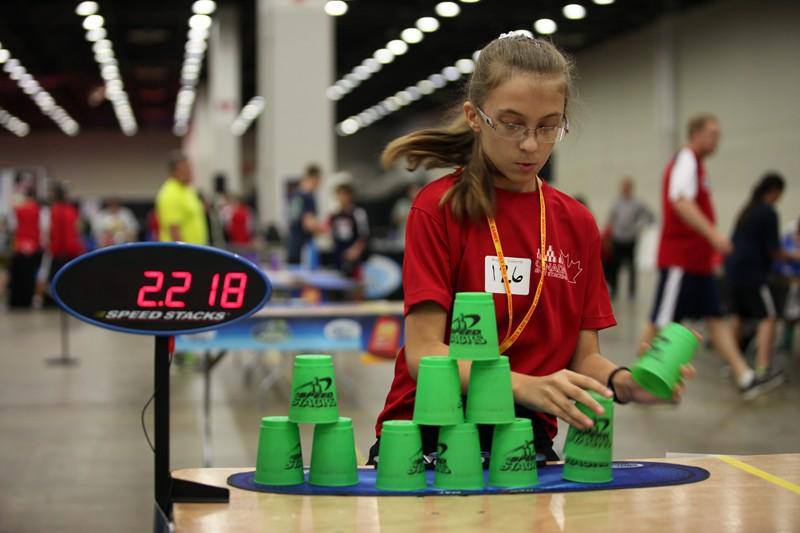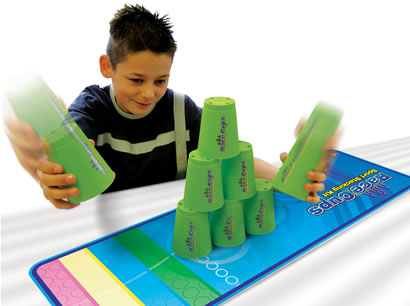Sport Stacking
Sport Stacking ( German: Sport stacking ) is a skill sport, in which a set of twelve molded cups ( Cups) pyramids and abstapelt again in a certain order. This one tries to be as fast and error free. In the media, the sport by the brand " Speed Stacks " is sometimes referred to as " speed stacking " (rapid stacking ).
General
The special cups were invented in the 1980s in California and sold under the name " Kup Stax " by Hasbro. The sport and the modern disciplines were then developed by the American elementary school teacher Bob Fox, who founded the company Speed Stacks. 2004 saw the sport the way from the U.S. to Germany.
In the U.S., over 20,000 schools take part in a sport stacking program. Since the stacks of cups in America is popular for several years, regularly Championships will be held in some schools.
Also in Germany is becoming increasingly popular sport stacking both in schools and clubs.
Benefit
Speed Stacking promotes ambidexterity, the eye -hand coordination and reaction time. In the human brain there is a crossover circuit, because the left side of the brain controls the right half of the body and vice versa. Almost all the nerves cross over in the brain that connect the two halves is a "bar " made of extra thick nerve fibers, also called the corpus callosum. People learn and work best when they have a good access to both sides of the brain and information about the corpus callosum can be exchanged.
Sport Stacking activated by the alternate work with left and right hand and crossing the center of the face, both brain hemispheres. There are new links formed, built new " nerve roads " that can be expanded with regular employment with Sport Stacking. This newly created neural pathways can be helpful when learning other content or skills, such as playing an instrument, reading and writing or playing sports. It can be achieved similar positive effects, such as juggling.
Sport Stacking is also used by people with disabilities and provides them with good opportunities to train their motor skills and to draw the same positive benefits as non-disabled sport stacker.
Scientific studies published:
- Stacking improves hand -eye coordination and reaction speed by up to 30%. Published in " Perceptual and Motor Skills" in 2004.
- An EEG - study by Melanie A. Hart, Ph.D. Assistant Professor Department of Health, Exercise and Sport Sciences at Texas Tech University is the use of both hemispheres of the brain, which is responsible for positive effects ( see above). Publication awarded by the Poster Award from AAHPERD The advantages with respect to the reaction rate was not hard to prove.
- The kinesiology faculty of Towson University, Towson, MD was able to show positive effects in 2007 of a six-week Stacking course regardless of their gender on the reading skills of participating students.
- The University of Nevada, meanwhile, served in 2007 as the stacking test method to distinguish what influence on the training influence observation and dialogue with the teacher.
Disciplines and Tournaments
The official rules, the WSSA established (World Sport Stacking Association). Already for several years through the World Cup and other tournaments, and adds in the different age classes of national and international record lists in which all valid, provided on WSSA tournaments records are collected. The WSSA also performs all the national championships, in addition to the U.S. and the German championship including in Canada, UK, Australia, Mexico, Japan and Switzerland. During the tournaments you meet all age groups from under 4 to over 60 Oldest participants who had previously participated in competitions over 75 years old.
In 2006, the brand FlashCups the ISSF (International Sport Stacking Federation) was established, which also performs tournaments and cup each brand allows this. In addition, new forms of competition have been introduced in recent years, such as the stack duel developed by the ISSF, compete in the Stacker knock-out system against each other.
The three individual event disciplines are:
- 3-3-3 (Overall World Record: 1.482 s, Chandler Miller, United States)
- 3-6-3 (overall world record: 1,911 s, William Orrell, USA )
- Cycle (Overall World Record: 5,595 s, William Polly, USA )
In addition, there are disciplines such as relay or double. In the double pits two competitors with a Becherset the Cycle, one of only the right, the other must use only the left hand. In addition to the normal two, there was until the beginning of 2007 nor the Adult/Child- ( adult / child) and the parent / child ( parent / child ) double. In a season four athletes to stack behind each other of the 3-6-3 or the Cycle.
The double and relay competition disciplines are:
- Double Cycle (Overall World Record: 6,530 Timo Reuhl and Ryan Powell, Germany )
- Time relay 363 (Overall World Record: 13.187, Wills and Not Wills, United States)
- Head -To -Head Season 3-6-3 ( Competitive mode against each other, not against the clock )
- Head -To -Head Season Cycle ( Competitive mode against each other, not against the clock )
The most commonly cited and most famous world record is the record of all age classes in the discipline cycle. This was for many years held with 7.43 s of the American Emily Fox and the video of it is widely available on the video sharing sites. Since early 2007, the record but was improved several times. The current world record now stands at 5.93 s, held by Steven Purugganan.
In some tournaments, there are also independent competitions for disabled athletes. Athletes will be here also divided according to their level of disability in addition to the ages, and is determined at the 3- 6-3 - time. Who will make the 3-6-3 a time of under 16 seconds belongs to level 1, who is about to level 2 as one of the best Stackebrandt gutters Level 1 applies the German Bianca ash in cycle times of less than 13 now can accomplish seconds.
The German Sport Stacking Championships took place in January 2007 for the third time and drew nearly 400 participants from all over the country. At the World Championships WSSA in April 2007 in Denver, United States participated in almost 1200 athletes, such as Stacker 150 were represented in each age group on average. At the 2008 World Cup similar number of participants have been reached, the results have improved a lot but compared to last year. In the most populated age groups 13-14 and 15-18 years were not sufficient in the disciplines Cycle or partially double times to the place in the final, in 2006, were still a world record.
On April 14th and 15th 2012 the world championship took place for the first time in Germany in Hessen Butzbach, where about 250 Stacker participated from 20 countries. The lower number of participants can be explained, since the World Cup since 2011 is an invitational tournament and may only take limited people from different nations there.
Fun disciplines
A Fun -discipline is developed by the WSSA Germany, so-called " stack 5". He was first tried out in Germany in 2007 and introduced as a demo competition at the 2008 World Championships in Denver. Here, have a total of five stacked pattern and additionally running tracks are mastered. The procedure is the following:
- The athlete starts at table 1 with a 3-3-3 and then runs for two yards in his back standing table 2
- There he stackt a 3-6-3 and runs back to table 1
- Here is a complete cycle is stacked and again to
- Running table 2 where again a 3-6-3 is to deal with
- Back to table 1 is completed with a 3-3-3 and finally stopped time.
Time mat / Timer
On WSSA tournaments a so-called "Stack Mat " has been used since 2003. Before the days of arbitrators had been taken with a handheld stopwatches. The time mat is a device in which the athletes themselves to start and stop the time. She has contact surfaces, on which the athlete puts his hands. When a hand leaves the timer starts timing. It ends when resting after stacking again both hands on the contact areas. The referees must only verify that there was no error stack and can record the time then.
Meanwhile, this time taking technique was also adopted by other sports. So it is used in memory championships in the discipline Speedcards and speed cubing ( cube ) tournaments.
On ISSF tournaments, "Stack Mat " can also be used, but the Stacker has the alternative option to use the mat and the timer of the brand FlashCups. The mat of the company FlashCups is slightly thicker than the "Stack Mat " by Speed Stacks and the timer is a special one-hand timer that allows you to start with just one hand and to stop while the timer of Speed Stacks both hands should be placed on contact surfaces so that it responds.
Sport Stacking in Germany
The teacher Petra Bauer had brought the sport after a stay in the USA to Germany. In the spring of 2005, four students in their school participated in the World Cup in the United States. Miriam Christian, Timo Reuhl, Christoph Sauer and Marcus Reitz were achieved in several titles and unexpectedly came afterwards in numerous German television programs, among others, Star TV and TV total. A result, the sport in Germany became known abruptly and won many followers. The sport is so far mainly operated by students.
2009, 2010 and 2012, was a native of Bad Driburg Florian Friedrich world champion.










